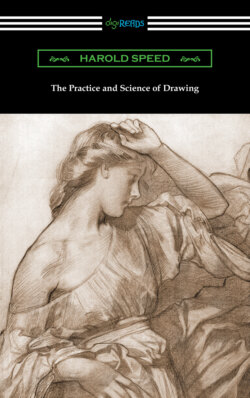Читать книгу The Practice and Science of Drawing - Harold Speed - Страница 31
На сайте Литреса книга снята с продажи.
ОглавлениеBut there is another basis of expression directly related to visual appearances that in the fulness of time was evolved, and has had a very great influence on modern art. This form of drawing is based on the consideration of the flat appearances on the retina, with the knowledge of the felt shapes of objects for the time being forgotten. In opposition to line drawing, we may call this Mass Drawing.
The scientific truth of this point of view is obvious. If only the accurate copying of the appearances of nature were the sole object of art (an idea to be met with among students) the problem of painting would be simpler than it is, and would be likely ere long to be solved by the photographic camera.
This form of drawing is the natural means of expression when a brush full of paint is in your hands. The reducing of a complicated appearance to a few simple masses is the first necessity of the painter. But this will be fully explained in a later chapter treating more practically of the practice of mass drawing.
Showing how early Chinese masters had developed the mass-drawing point of view.
The art of China and Japan appears to have been more [influenced by this view of natural appearances than that of the West has been, until quite lately. The Eastern mind does not seem to be so obsessed by the objectivity of things as is the Western mind. With us the practical sense of touch is all powerful. “I know that is so, because I felt it with my hands” would be a characteristic expression with us. Whereas I do not think it would be an expression the Eastern mind would use. With them the spiritual essence of the thing seen appears to be the more real, judging from their art. And who is to say they may not be right? This is certainly the impression one gets from their beautiful painting, with its lightness of texture and avoidance of solidity. It is founded on nature regarded as a flat vision, instead of a collection of solids in space. Their use of line is also much more restrained than with us, and it is seldom used to accentuate the solidity of things, but chiefly to support the boundaries of masses and suggest detail. Light and shade, which suggest solidity, are never used, a wide light where there is no shadow pervades everything, their drawing being done with the brush in masses.
When, as in the time of Titian, the art of the West had discovered light and shade, linear perspective, aerial perspective, &c., and had begun by fusing the edges of the masses to suspect the necessity of painting to a widely diffused focus, they had got very near considering appearances as a visual whole. But it was not until Velazquez that a picture was painted that was founded entirely on visual appearances, in which a basis of objective outlines was discarded and replaced by a structure of tone masses.
Plate XI. Photo Anderson
LOS MENIÑAS. BY VELAZQUEZ (PRADO)
Probably the first picture ever painted entirely from the visual or impressionist standpoint.
